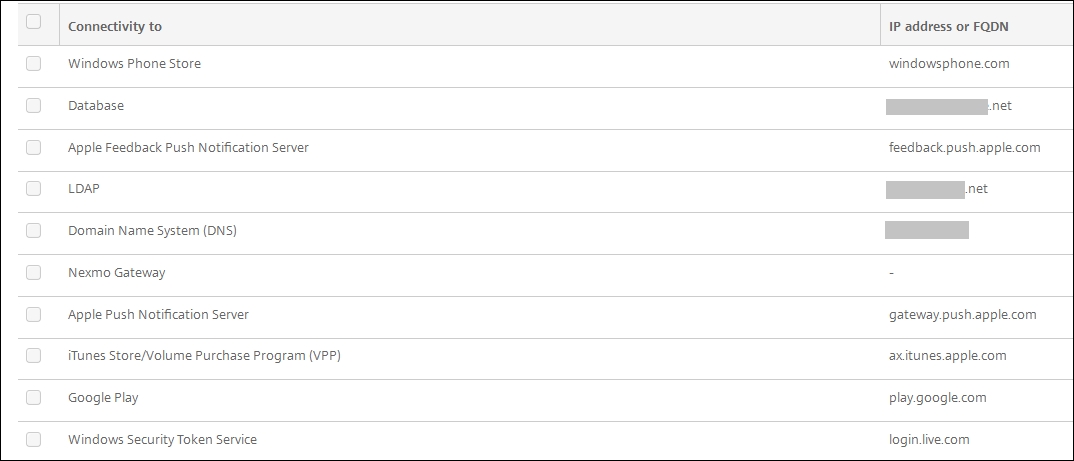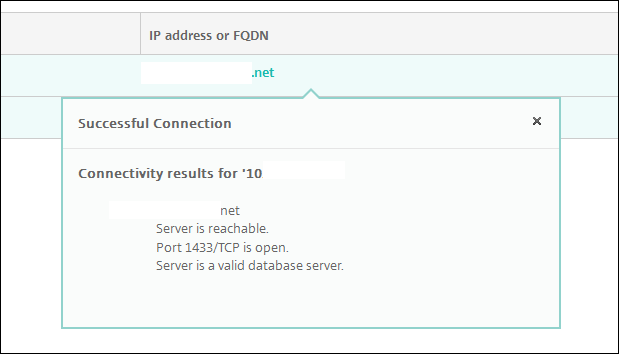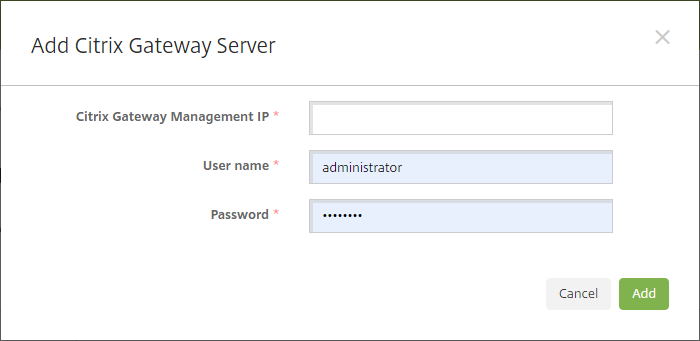-
Endpoint Management integration with Microsoft Endpoint Manager
-
Certificates and authentication
-
Client certificate or certificate plus domain authentication
-
Authentication with Azure Active Directory through Citrix Cloud™
-
Authentication with Azure Active Directory Group-Based Administration
-
Authentication with Azure Active Directory through Citrix Gateway for MAM enrollment
-
Authentication with Okta through Citrix Gateway for MAM enrollment
-
Authentication with an on-premises Citrix Gateway through Citrix Cloud
-
-
Connectivity checks
-
This content has been machine translated dynamically.
Dieser Inhalt ist eine maschinelle Übersetzung, die dynamisch erstellt wurde. (Haftungsausschluss)
Cet article a été traduit automatiquement de manière dynamique. (Clause de non responsabilité)
Este artículo lo ha traducido una máquina de forma dinámica. (Aviso legal)
此内容已经过机器动态翻译。 放弃
このコンテンツは動的に機械翻訳されています。免責事項
이 콘텐츠는 동적으로 기계 번역되었습니다. 책임 부인
Este texto foi traduzido automaticamente. (Aviso legal)
Questo contenuto è stato tradotto dinamicamente con traduzione automatica.(Esclusione di responsabilità))
This article has been machine translated.
Dieser Artikel wurde maschinell übersetzt. (Haftungsausschluss)
Ce article a été traduit automatiquement. (Clause de non responsabilité)
Este artículo ha sido traducido automáticamente. (Aviso legal)
この記事は機械翻訳されています.免責事項
이 기사는 기계 번역되었습니다.책임 부인
Este artigo foi traduzido automaticamente.(Aviso legal)
这篇文章已经过机器翻译.放弃
Questo articolo è stato tradotto automaticamente.(Esclusione di responsabilità))
Translation failed!
Connectivity checks
From the Citrix Endpoint Management Troubleshooting and Support page, you can check the Citrix Endpoint Management connection to NetScaler Gateway and to other servers and locations. To run Citrix Endpoint Management connectivity checks, you need the Support or the Admin role. Set this role using Role-Based Access Control (RBAC). For more information on assigning roles, see Configure roles with RBAC.
Run Citrix Endpoint Management connectivity checks
-
In the Citrix Endpoint Management console, click the wrench icon in the upper-right corner of the console. The Troubleshooting and Support page appears.
-
Under Diagnostics, click Citrix Endpoint Management Connectivity Checks. The Citrix Endpoint Management Connectivity Checks page appears. If your Citrix Endpoint Management environment has clustered nodes, all nodes are shown.

-
Select the servers that you want to include in the connectivity test and then click Test Connectivity. The test results page appears.

-
Select a server in the test results table to see detailed results for that server.

For more information about connectivity checks that Citrix Endpoint Management can do and their details, see Connectivity check details.
Conducting NetScaler Gateway connectivity checks
-
On the Troubleshooting and Support page, under Diagnostics, click NetScaler Gateway Connectivity Checks. The NetScaler Gateway Connectivity Checks page appears. The table is empty if there’s no connection between Citrix Endpoint Management and NetScaler Gateway.

-
Click Add. The Add NetScaler Gateway Server dialog box appears.

-
In NetScaler Gateway Management IP, type the management IP address for the server running NetScaler Gateway that you want to test.
If you’re conducting a connectivity check for a NetScaler Gateway server that has already been added before, the IP address is provided.
-
Type your administrator credentials for this NetScaler Gateway.
If you’re conducting a connectivity check for a NetScaler Gateway server that has already been added before, the user name is provided.
-
Click Add. The NetScaler Gateway is added to the table on the NetScaler Gateway Connectivity Checks page.
-
Select the NetScaler Gateway server and then click Test Connectivity. The results appear in a test results table.
-
Select a server in the test results table to see detailed results for that server.
Connectivity check details
The following table lists various connectivity checks that Citrix Endpoint Management can do and include details about each check.
| Connectivity to | IP address or FQDN | Details |
|---|---|---|
| Apple Push Notification Server | api.push.apple.com | Checks the connectivity between the Apple Push Notification Server and the Citrix Endpoint Management node. Apple Push Notification Server is required to send messages to iOS and macOS devices. |
| Apple Feedback Push Notification Server | feedback.push.apple.com | Checks connectivity between Apple Feedback Server and the Citrix Endpoint Management node. Apple Feedback Push Notification Server gives you information about failed remote notifications sent to iOS and macOS devices. |
| Citrix License Server | IP address of License Server | Checks connectivity between Citrix License Server and the Citrix Endpoint Management node. Servers running Citrix products contact Citrix License Server to get licenses. |
| NetScaler Gateway | FQDN of NetScaler Gateway configured in Citrix Endpoint Management | Checks connectivity between NetScaler Gateway and the Citrix Endpoint Management node. NetScaler Gateway is used by Citrix Endpoint Management client apps (such as Citrix Secure Mail and Citrix Secure Web) to connect through a VPN server for access to internal networks. |
| Database | IP address or FQDN of Database Server | Checks connectivity between the Citrix Endpoint Management database and the Citrix Endpoint Management node. |
| Domain Name System (DNS) | IP address configured in Citrix Endpoint Management | Checks connectivity between the DNS server and the Citrix Endpoint Management node. |
| Secure Ticket Authority service | localhost | Checks the Citrix Endpoint Management node connection to authentication services, STA (Secure Ticket Authority) services, and cluster services. |
| Firebase Cloud Messaging (FCM) Server | Checks connectivity between FCM Server and the Citrix Endpoint Management node. Using FCM, you can notify a client app that a new email or other data is available to sync. You can send notification messages to drive user engagement and retention. FCM is a replacement for Google Cloud Messaging (GCM). | |
| Google Play | play.google.com | Checks connectivity between Google Store Server and the Citrix Endpoint Management node. Google Play is used to offer services that include a managed, private enterprise app delivery store. |
| iTunes Store/Volume Purchase | vpp.itunes.apple.com | Checks connectivity between Apple Store Server and the Citrix Endpoint Management node. The Apple Store is used to offer services that include a managed, private enterprise app delivery store. |
| LDAP | IP address or FQDN of LDAP configured in Citrix Endpoint Management | Checks connectivity between the LDAP server and the Citrix Endpoint Management node. |
| Microsoft Push Notification Server | sin.notifiy.windows.com | Checks connectivity between Windows Notification Server and the Citrix Endpoint Management node. Windows Notification Server is used to send messages to Windows devices. |
| ShareFile Service | IP address or FQDN of ShareFile Service configured in Citrix Endpoint Management | Checks connectivity between ShareFile Service and Citrix Endpoint Management. ShareFile The Service is a secure cloud-based platform for businesses to store and share large files. |
| Windows Desktop/Tablet Store | windows.microsoft.com | Checks connectivity between the Windows Desktop/Tablet Store and the Citrix Endpoint Management node. Windows Desktop/Tablet Store is used to offer services that include a managed, private enterprise app delivery store. |
| Windows Security Token Service | login.live.com | Checks connectivity between Windows Security Token Server and the Citrix Endpoint Management node. Windows Security Token Service supports two-factor authentication (domain plus security token) for Windows devices. |
Share
Share
This Preview product documentation is Citrix Confidential.
You agree to hold this documentation confidential pursuant to the terms of your Citrix Beta/Tech Preview Agreement.
The development, release and timing of any features or functionality described in the Preview documentation remains at our sole discretion and are subject to change without notice or consultation.
The documentation is for informational purposes only and is not a commitment, promise or legal obligation to deliver any material, code or functionality and should not be relied upon in making Citrix product purchase decisions.
If you do not agree, select I DO NOT AGREE to exit.